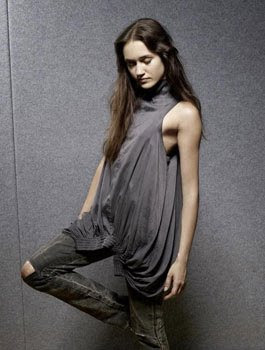 By Cathrin Schaer
By Cathrin SchaerBERLIN: White and red fluorescent tubes dangled from the ceiling, and art depicting male genitalia rested against the wall. Strange videos flashed across spray-painted computer monitors, and weird gold fabric caught the eye amid the racks of one-off fashions, mainly black, by young designers you have never heard of.
Gundega Lasmane-Gecs, the boutique's owner, stood in the middle of it all, surveying her domain. "Sometimes I wake up in the morning, and I wonder what the hell I'm doing here," she said in her perfect but accented English. "But then I think, well, it just feels right."
Four months ago Lasmane-Gecs and her husband, Agris Gecs, opened a trendy little boutique called Talka in the fast-becoming-fashionable Friedrichshain district of Berlin. Such places are far from unusual in wildly inventive, uber-creative Berlin.
What is different about Talka's owners and its stock is where they come from: Latvia.
The Gecs and the designers they work with are part of a small but growing movement of fashion designers from Eastern Europe coming to the West.
And, for many, the first logical stop is Berlin.
"Milan does not have an avant-garde scene, Paris is very expensive, and New York and London are so much further away," explains Ulrike Möslinger, who directs marketing for the French department store Galleries Lafayette in Berlin and is on the board of Create Berlin, an advocacy group for local design. "Düsseldorf has more industry, but the infrastructure for young designers is better here in Berlin. The rents are not expensive, and it's very easy to open a store."
Retail rents in central Berlin are around €2,600 per square meter a year, or $310 a square foot, while similar space in Paris could be as much as €8,000 per square meter - and it is likely that startup stores or young designers would seek even less expensive property, further out from the center into what was formerly East Berlin.
"Berlin sees itself as the middle-European capital, a bridge between East and West and, although I don't know if all Eastern European designers see it that way yet, I think it has that potential for them," said Silvia Kadolsky, director and owner of the Berlin branch of Esmod, the private international fashion school founded in Paris in 1841.
At least one Eastern European designer agrees. "I think there are more possibilities for me here," says Agné Kuzmickaité, a young Lithuanian with three collections to her name, who won a year's accommodation and use of an atelier here in a competition last year. "I think in France it would be very hard for someone like me. To me it feels like Paris is yesterday - and Berlin has the potential to be tomorrow."
And while the streets of Berlin are not lined with stores stocking the latest from Lithuania or the Russian Federation quite yet, there is plenty of evidence of the trend.
Labels like Penelope's Sphere, whose designer, Tamari Nikoleishvili, is from Georgia, and Mareunrols, created by Marite Mastina and Rolands Peterkops of Latvia, hang next to the work of designers from Germany, Sweden, Japan and England on racks around the city. And new boutiques like Talka, Access and Redspective specialize in Eastern European design.
"For me, starting a store here was a really easy decision," says Cynthia Carson, co-owner of Redspective - where alongside fanzines from the Czech Republic and music compilations from St. Petersburg nightclubs, they stock what they describe as "urban clothing" designed in collaboration with street, graffiti and other artists from Eastern Europe. "There is no other city in Europe that draws such a line between East and West."
But, as with any fashion label in any big city, it's not all easy going in Berlin.
"It's a good place to live and work, in fact, it's a great place. But not such a good place to sell," says Nikoleishvili of Penelope's Sphere, who worked for Vivienne Westwood and Marjan Pejoski in London before coming to Berlin.
"I have people who love my stuff, but the most expensive things are always bought by tourists," Nikoleishvili says. Her top-end designs sell for several hundred euros, an extravagance for many in a city with slow economic growth and high unemployment.
Mastina and Peterkops, who design Mareunrols, understand the problem. "On one hand Berlin is possibly the best city in Europe for young fashion labels to be based as it has a thriving arts scene and relatively cheap rent," they said in an e-mail interview. "On the other hand Berlin poses many challenges to a label like ours, which is catering for the top end of the market."








No comments:
Post a Comment